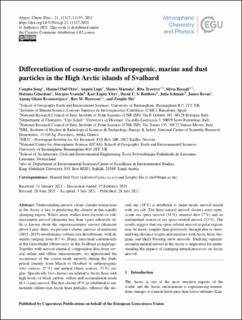| dc.contributor.author | Song, Congbo | |
| dc.contributor.author | Dall'Osto, Manuel | |
| dc.contributor.author | Lupi, Angelo | |
| dc.contributor.author | Mazzola, Mauro | |
| dc.contributor.author | Traversi, Rita | |
| dc.contributor.author | Becagli, Silvia | |
| dc.contributor.author | Gilardoni, Stefania | |
| dc.contributor.author | Vratolis, Stergios | |
| dc.contributor.author | Yttri, Karl Espen | |
| dc.contributor.author | Beddows, David C.S. | |
| dc.contributor.author | Schmale, Julia | |
| dc.contributor.author | Brean, James | |
| dc.contributor.author | Kramawijaya, Agung Ghani | |
| dc.contributor.author | Harrison, Roy M. | |
| dc.contributor.author | Shi, Zongbo | |
| dc.date.accessioned | 2021-08-17T09:12:55Z | |
| dc.date.available | 2021-08-17T09:12:55Z | |
| dc.date.created | 2021-08-12T14:15:35Z | |
| dc.date.issued | 2021 | |
| dc.identifier.citation | Atmospheric Chemistry and Physics. 2021, 21, 11317-11335. | en_US |
| dc.identifier.issn | 1680-7316 | |
| dc.identifier.uri | https://hdl.handle.net/11250/2768723 | |
| dc.description.abstract | Understanding aerosol–cloud–climate interactions in the Arctic is key to predicting the climate in this rapidly changing region. Whilst many studies have focused on submicrometer aerosol (diameter less than 1 µm), relatively little is known about the supermicrometer aerosol (diameter above 1 µm). Here, we present a cluster analysis of multiyear (2015–2019) aerodynamic volume size distributions, with diameter ranging from 0.5 to 20 µm, measured continuously at the Gruvebadet Observatory in the Svalbard archipelago. Together with aerosol chemical composition data from several online and offline measurements, we apportioned the occurrence of the coarse-mode aerosols during the study period (mainly from March to October) to anthropogenic (two sources, 27 %) and natural (three sources, 73 %) origins. Specifically, two clusters are related to Arctic haze with high levels of black carbon, sulfate and accumulation mode (0.1–1 µm) aerosol. The first cluster (9 %) is attributed to ammonium sulfate-rich Arctic haze particles, whereas the second one (18 %) is attributed to larger-mode aerosol mixed with sea salt. The three natural aerosol clusters were open-ocean sea spray aerosol (34 %), mineral dust (7 %) and an unidentified source of sea spray-related aerosol (32 %). The results suggest that sea-spray-related aerosol in polar regions may be more complex than previously thought due to short- and long-distance origins and mixtures with Arctic haze, biogenic and likely blowing snow aerosols. Studying supermicrometer natural aerosol in the Arctic is imperative for understanding the impacts of changing natural processes on Arctic aerosol. | en_US |
| dc.language.iso | eng | en_US |
| dc.rights | Navngivelse 4.0 Internasjonal | * |
| dc.rights.uri | http://creativecommons.org/licenses/by/4.0/deed.no | * |
| dc.title | Differentiation of coarse-mode anthropogenic, marine and dust particles in the High Arctic islands of Svalbard | en_US |
| dc.type | Peer reviewed | en_US |
| dc.type | Journal article | en_US |
| dc.description.version | publishedVersion | en_US |
| dc.rights.holder | © Author(s) 2021. | en_US |
| dc.source.pagenumber | 11317-11335 | en_US |
| dc.source.volume | 21 | en_US |
| dc.source.journal | Atmospheric Chemistry and Physics | en_US |
| dc.identifier.doi | 10.5194/acp-21-11317-2021 | |
| dc.identifier.cristin | 1925634 | |
| dc.relation.project | NILU: 112002 | en_US |
| dc.relation.project | NILU: 115058 | en_US |
| cristin.ispublished | true | |
| cristin.fulltext | original | |
| cristin.qualitycode | 2 | |

